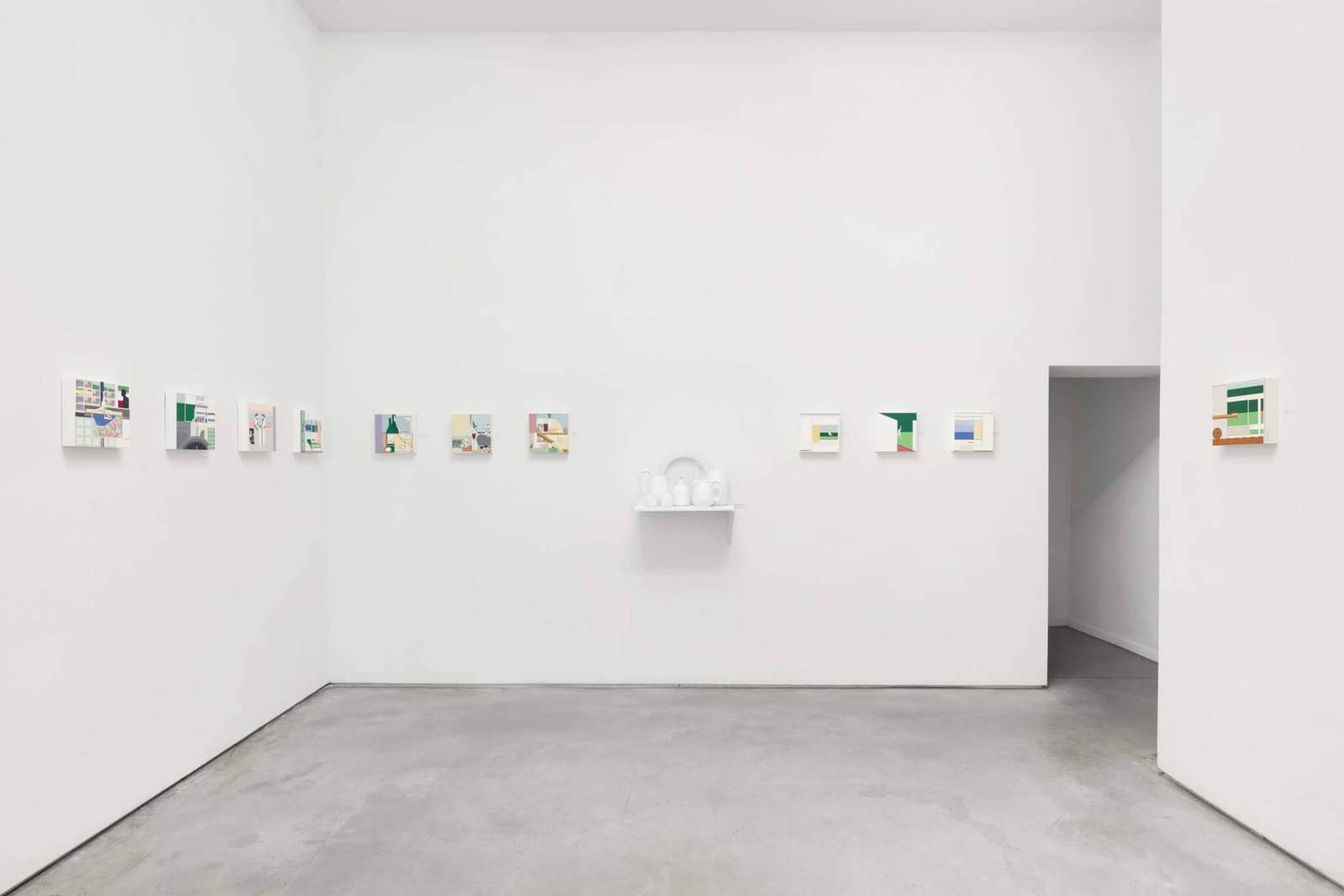a83 extends an exhibition of works by Atlanta-based architect Anthony Ames
Anthony Ames, Fifty Paintings
a83
83 Grand Street
New York, New York 10013
Open through September 18
In case you missed its initial run, a83, a gallery/print studio/archive in Soho, has extended its late-summer exhibition of works by Atlanta-based architect Anthony Ames through September 18. The exhibition, which initially ran from July 9 to August 8, is a fantastical retrospective of Ames’s architectural media. It comprises 47 paintings (realized between 1985 and 2020), three prints (made in collaboration with John Nichols Printmakers in 1989), and one seven-piece porcelain set (fabricated in 1990). For the Ames enthusiasts, there are narrative easter eggs embedded within each work; for the architectural purists, there are plenty of winks at historical modernist references; and for the casual visitor, there is the aesthetic gratification of the au courant postmodern vibes.
Ames began painting in 1984, a year after he won the Architecture League’s Emerging Voices award. His visual sensibility demonstrates a strong attachment to early-twentieth century modernism and love for the game of basketball. “Architecture and basketball do … have a commonality in that they are both about creating space,” he observed in the recent namesake book published last year by ORO Editions, which preceded this exhibition. Ames’s paintings oscillate somewhere between the formality of a still life, the dynamism of sculptural relief, and the juxtaposed delight of collage.

Ames reveals his methodology in the book version of Fifty Paintings: “Initially each panel is painted white. The surface is then inscribed in graphite … as a line drawing. … The paint is allowed to touch the line—barely—but not the paint of the adjacent area. … Masking is prohibited.” With this kind of painterly precision and smoothness, I couldn’t help but think, “Nothing but net.” Scanning the gallery walls, the inoffensive color palette connects the various works across space—physically in the gallery—and chronological time. The soft hues are the same paints Ames uses in his built works: Pratt & Lambert acrylic latex house paint. This chromatic systemization expands the architecture of Ames’s paintings to include his catalog of houses.
Varying in scale and shape—with the largest panel being a 48-inch square panel and the smallest an idealized 10-inch square—Ames signs and dates each painting with Le Corbusier–like stenciled letters along the edge. Instead of cloth canvas, Ames opts for wood panels—a nod to standardized building materials. Nearly all the paintings measure 2 inches in depth, reinforcing them as objects. Ames declares: “Perhaps this is a reaction to the ephemeral nature of the ‘cyber-space,’ virtual reality image.” Funnily enough, I learned of Ames’s architectural work a few years ago through the homogenized square format of Instagram. Yet unlike the quick consumption of scrolling feeds, standing before each painting demands close attention to the constructed mise-en-scéne. (The James Rosenquist–esque “cornice-to-bowl-of-spaghetti” is one of my favorite moments). The generosity of spaces and interesting things—trees, houses, columns, chairs, rugs, books, guitars, cars, planes, pitchers, hoops, and so on—within a given composition reveals a thoughtfulness in the placement of each point, line, and object.

The larger works are placed in the front room, including the dimensional White Compositions that pop off the panels with spatial complexities rendered simply in a monochromatic wash. 25 petite paintings measure at 10-inches square and wrap the back room at eye-level, like the ribbon windows featured in many of the pieces. They’re an immersive experience. The Swid Powell–produced glazed porcelain set of generically specific dinnerware sits on the center of the back wall—they are key objects in translating seemingly obscure yet familiar shapes in the paintings.
It’s not a reach to say that Ames’s architectural works read as inside-baseball—or basketball, in this case. The description text in the gallery hand-out, as well as Andrea Simitch’s introduction in the book, traces the conceptual linage of Ames’s paintings back to the rigid dialog of Colin Rowe and Robert Slutzky’s 1955 essay “Transparency” and György Kepes’s 1944 publication, Language of Vision. And, sure, “literal and phenomenal” can categorize (or post-rationalize) such work, but this makes the work feel as if it were contrived or pedantic to the voices (or audience) currently being pushed out of the disciplinary picture in recent years.

The paintings undoubtedly communicate the “high,” capital-A Architecture of modernism, particularly that of media- and brand-savvy figures like Corb, but they also acknowledge figures like Michael Jordan as equally influential to Ames. The latter provides a crucial catalyst for the shifting zeitgeist in architecture discourse today: uncovering alternative histories and new architectural heroes. (Architecture is more of a team sport these days—much like Phil Jackson’s underdog transformation of Michael Jordan and the Chicago Bulls in the 1990s.) Sure, the works reference Corb’s Villa Savoye and Villa Stein, but a larger pair of scenes also reference Bo Diddley’s Twang Machine and the Les Paul of rockers who followed in his footsteps. Within each painstakingly technical work—between the hoops and guitars, the villas and vases—I’m reminded of Allen Iverson’s 2002 press conference in which he drops the word “practice” 22 times to emphasize that even greatness has its vulnerabilities.

My hope is that viewers take in the exhibition with the same playful spirit that Ames presents at the end of his book: A simple sketch depicts Nike’s dunking Jumpman in motion, with round “Corb glasses” flying off. “Whether Corb actually ‘had game’ will forever remain speculation,” Ames quipped. I’d like to imagine the sketch communicates something more like Jumpman as Modulor, or Jordan as Architect. Either way, I’m grateful to a83 for going into overtime with Fifty Paintings.
Courtney Coffman is a writer and an editor based in Princeton, New Jersey.



